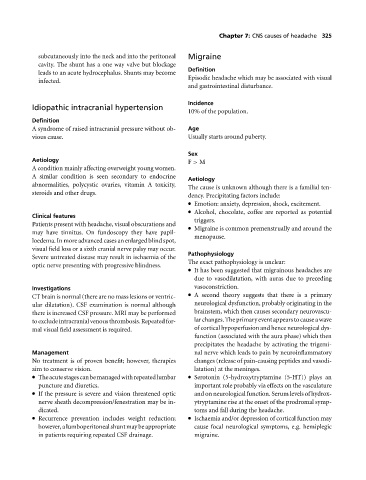Page 329 - Medicine and Surgery
P. 329
P1: FAW
BLUK007-07 BLUK007-Kendall May 25, 2005 18:18 Char Count= 0
Chapter 7: CNS causes of headache 325
subcutaneously into the neck and into the peritoneal Migraine
cavity. The shunt has a one way valve but blockage
Definition
leads to an acute hydrocephalus. Shunts may become
Episodic headache which may be associated with visual
infected.
and gastrointestinal disturbance.
Incidence
Idiopathic intracranial hypertension
10% of the population.
Definition
A syndrome of raised intracranial pressure without ob- Age
vious cause. Usually starts around puberty.
Sex
Aetiology F > M
Acondition mainly affecting overweight young women.
A similar condition is seen secondary to endocrine
Aetiology
abnormalities, polycystic ovaries, vitamin A toxicity,
The cause is unknown although there is a familial ten-
steroids and other drugs.
dency. Precipitating factors include:
Emotion: anxiety, depression, shock, excitement.
Alcohol, chocolate, coffee are reported as potential
Clinical features
triggers.
Patients present with headache, visual obscurations and
Migraine is common premenstrually and around the
may have tinnitus. On fundoscopy they have papil-
menopause.
loedema. In more advanced cases an enlarged blind spot,
visual field loss or a sixth cranial nerve palsy may occur.
Pathophysiology
Severe untreated disease may result in ischaemia of the
The exact pathophysiology is unclear:
optic nerve presenting with progressive blindness.
It has been suggested that migrainous headaches are
due to vasodilatation, with auras due to preceding
Investigations vasoconstriction.
CT brain is normal (there are no mass lesions or ventric- Asecond theory suggests that there is a primary
ular dilatation). CSF examination is normal although neurological dysfunction, probably originating in the
there is increased CSF pressure. MRI may be performed brainstem, which then causes secondary neurovascu-
toexcludeintracranialvenousthrombosis.Repeatedfor- larchanges.Theprimaryeventappearstocauseawave
mal visual field assessment is required. of cortical hypoperfusion and hence neurological dys-
function (associated with the aura phase) which then
precipitates the headache by activating the trigemi-
Management nal nerve which leads to pain by neuroinflammatory
No treatment is of proven benefit; however, therapies changes (release of pain-causing peptides and vasodi-
aim to conserve vision. latation) at the meninges.
Theacutestagescanbemanagedwithrepeatedlumbar Serotonin (5-hydroxytryptamine (5-HT)) plays an
puncture and diuretics. important role probably via effects on the vasculature
If the pressure is severe and vision threatened optic and on neurological function. Serum levels of hydrox-
nerve sheath decompression/fenestration may be in- ytryptamine rise at the onset of the prodromal symp-
dicated. toms and fall during the headache.
Recurrence prevention includes weight reduction; Ischaemia and/or depression of cortical function may
however,alumboperitonealshuntmaybeappropriate cause focal neurological symptoms, e.g. hemiplegic
in patients requiring repeated CSF drainage. migraine.

